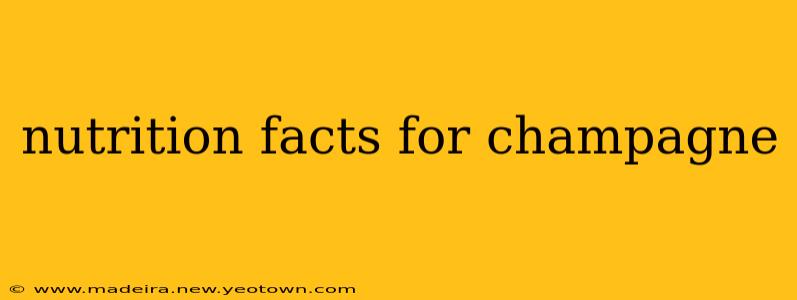Uncork the Truth: Nutrition Facts for Champagne and Sparkling Wine
Champagne. The name itself conjures images of elegance, celebration, and perhaps, a touch of guilt. But what's really in that bubbly elixir? Let's pop the cork on the nutritional facts of champagne and sparkling wine, demystifying the calories and components of this festive favorite. This isn't just about numbers; it's about understanding what you're enjoying and making informed choices.
My journey into the world of champagne nutrition started with a simple question: "Is champagne really that bad for you?" The answer, like most things in life, is nuanced. It depends on the amount consumed, of course, but also the type of champagne.
What are the Calories in a Glass of Champagne?
A typical 5-ounce (150ml) glass of champagne contains roughly 80-100 calories. However, this can vary depending on the sweetness level (brut, extra dry, etc.) and the brand. Sweeter champagnes generally contain more sugar and therefore more calories. Remember, those calories are essentially from sugar and alcohol.
What are the Macronutrients in Champagne?
Let's break down the main components beyond calories:
- Carbohydrates: Champagne does contain carbohydrates, primarily in the form of sugars. The amount varies significantly depending on the sweetness. Brut champagnes, which are the driest, typically contain the least amount of sugar.
- Alcohol: The alcohol content of champagne is usually around 12%, which is a significant contributor to its caloric value. Alcohol provides empty calories—meaning it offers little to no nutritional value.
- Protein and Fat: Champagne contains negligible amounts of protein and fat.
Does Champagne Have Any Nutritional Benefits?
While champagne isn't a nutritional powerhouse, it does offer some potential benefits, though these are minimal compared to the potential downsides of excessive consumption:
- Antioxidants: Some studies suggest that champagne, like other wines, contains antioxidants that may offer some health benefits, but this needs further research and is certainly outweighed by the negative impacts of excessive alcohol consumption.
- Polyphenols: Grapes contain polyphenols, which are associated with potential cardiovascular benefits. Again, these are present in much smaller amounts than in a glass of red wine.
Is Champagne Good for Weight Loss?
No, champagne is not a weight-loss-friendly beverage. Its calorie content, primarily from sugar and alcohol, can contribute to weight gain if consumed regularly in excess. The alcohol content also interferes with the body’s ability to metabolize fats.
What's the Difference in Nutrition Between Champagne and Other Sparkling Wines?
The nutritional profile of champagne is quite similar to other sparkling wines. The differences lie primarily in the production methods and the resulting taste and sweetness levels. However, the calorie count and sugar content can vary slightly.
How Can I Reduce the Calories and Sugar in My Champagne?
The simplest way to reduce the calories and sugar in your champagne is to choose a drier variety, such as Brut or Extra Brut. These styles contain less residual sugar compared to sweeter varieties. Opting for a smaller serving size is another simple strategy.
Is Champagne Gluten-Free?
Generally, yes, champagne is considered gluten-free. However, always check the label to be certain, as some brands might use additives that contain gluten.
Ultimately, enjoying champagne should be a mindful experience. By understanding the nutritional facts and making informed choices about the type and amount you consume, you can savour the bubbles without compromising your health goals. Remember, moderation is key!

